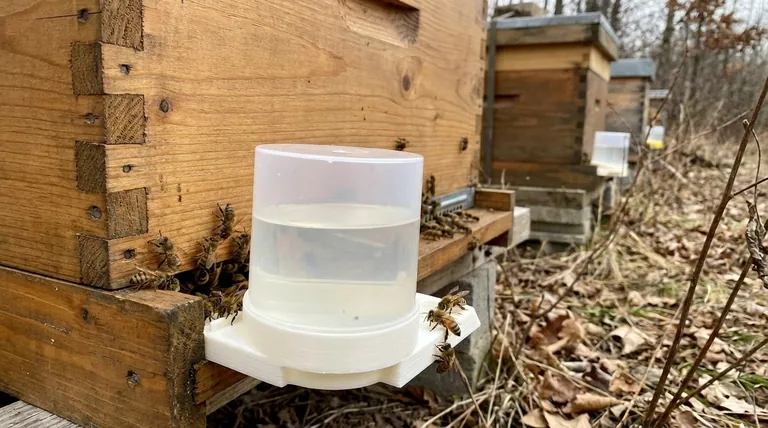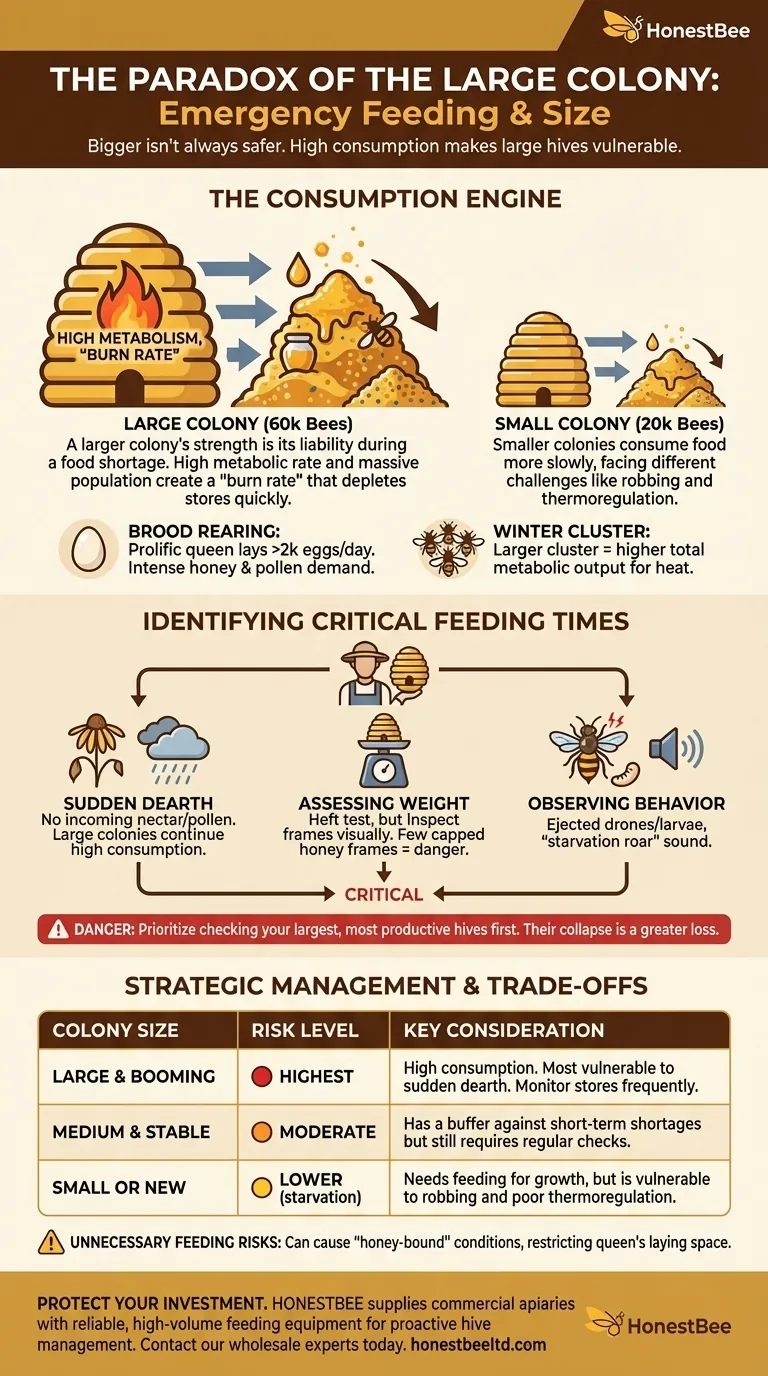The relationship is direct and often counterintuitive: a larger, more populous bee colony consumes its food stores significantly faster than a smaller one. This means that during a sudden lack of incoming nectar or pollen, your largest and seemingly strongest hives are often the most vulnerable to starvation and may require emergency feeding first.
A larger colony's strength in numbers becomes a liability during a food shortage. Its high metabolic rate and massive population create a "burn rate" that can deplete honey stores with surprising speed, demanding closer monitoring from the beekeeper.

The Paradox of the Large Colony
Many beekeepers assume a large, booming colony is self-sufficient. In reality, its size creates a significant demand for resources that makes it fragile in the face of sudden environmental changes.
Higher Population, Higher Consumption
The core principle is simple math. A hive with 60,000 bees requires substantially more honey for daily energy and pollen for protein than a hive with 20,000 bees.
Think of it as a large city versus a small town during a supply chain disruption. The city's resources will be exhausted far more quickly due to its larger population.
The Demands of Brood Rearing
A key driver of consumption is the brood nest. A prolific queen in a strong colony can lay over 2,000 eggs per day.
Raising this brood to maturity requires an immense and constant supply of pollen (for protein and fat) and honey (for energy). A large, expanding brood nest acts as a powerful engine, rapidly burning through the colony's stored food.
The Winter Cluster's Metabolism
During winter, bees form a cluster to generate heat and survive the cold. A larger cluster has more bees to generate heat, but it also has a greater total mass to keep warm.
This requires a higher metabolic output and, therefore, a higher rate of honey consumption throughout the winter months. A massive colony can burn through its winter stores weeks or even months before a smaller one.
Identifying When Emergency Feeding is Critical
Recognizing the signs of a food shortage is a critical beekeeping skill, especially when managing large colonies that can crash quickly.
The Dangers of a Sudden Dearth
A dearth is any period when there is a lack of incoming nectar or pollen. This can be caused by seasonal changes, drought, or even a week of cold, rainy weather that keeps foragers grounded.
Large colonies that were rapidly expanding their populations in anticipation of a continued nectar flow are the most susceptible to a sudden dearth. Their high consumption rate continues even when resources are no longer coming in.
Assessing Hive Weight and Stores
The most reliable method is direct inspection. A quick "heft test"—tilting the hive from the back—can give you a rough idea of its weight. A surprisingly light hive is a major red flag.
However, do not be deceived. A large colony can feel heavy due to the sheer weight of the bees themselves. You must open the hive and visually inspect the frames. Look for frames of capped honey; if you see very few, the colony is in danger.
Observing Bee Behavior
A colony on the brink of starvation may exhibit clear signs of stress. You might see ejected drones or developing larvae on the landing board as the colony tries to conserve resources.
Another sign can be an unusually loud "starvation roar" from within the hive, a sound distinct from the normal hum of a contented colony.
Understanding the Trade-offs and Risks
Emergency feeding is a powerful tool, but it must be used correctly. Misunderstanding a colony's needs can create new problems.
The Risk of Overlooking the Strong
The single biggest mistake a beekeeper can make is focusing all their worry on smaller, weaker hives while assuming the large ones are fine. Your most productive colonies are often your most fragile in a dearth.
Prioritize checking your largest hives first for food stores. Their collapse represents a much greater loss of productivity and genetics.
The Downside of Unnecessary Feeding
Feeding a colony that doesn't need it can be detrimental. If you provide excess sugar syrup when a nectar flow is on, the bees may store it in the brood nest.
This creates a "honey-bound" condition, where the queen runs out of empty cells to lay eggs in. This severely restricts colony growth and can even trigger an unwanted swarm.
Small Colonies Have Their Own Risks
While smaller colonies consume food more slowly, they face different challenges. They struggle to defend themselves from robbing by stronger colonies, a risk that increases when you feed.
They also have more difficulty thermoregulating, meaning a small winter cluster can perish from cold even with adequate food if the cluster is too small to generate sufficient heat.
A Practical Strategy Based on Colony Size
Your feeding and inspection strategy must be adapted to the specific needs of each colony.
- If your primary hive is large and booming: You must monitor its stores most frequently, especially during weather shifts or at the end of a nectar flow. It is your first priority for starvation risk.
- If you have a medium-sized, stable colony: It has a moderate buffer against short-term shortages. Regular checks are still required, but it is less prone to the sudden crash that a huge colony might face.
- If you have a small or new colony: Its main challenge is building strength, not immediate starvation. Feeding is often used to stimulate brood rearing and wax production, but you must use entrance reducers to protect it from being robbed.
By matching your vigilance to the colony's size, you can proactively support your bees and prevent catastrophic losses.
Summary Table:
| Colony Size | Risk Level | Key Consideration |
|---|---|---|
| Large & Booming | Highest | High consumption rate makes them most vulnerable to sudden dearth. Monitor stores frequently. |
| Medium & Stable | Moderate | Has a buffer against short-term shortages but still requires regular checks. |
| Small or New | Lower (starvation) / Higher (other risks) | Needs feeding for growth, but is vulnerable to robbing and poor thermoregulation. |
Protect your investment and prevent catastrophic hive loss. HONESTBEE supplies commercial apiaries and beekeeping equipment distributors with the reliable, high-volume feeding equipment and supplies needed to manage large colonies effectively. From bulk feeders to essential protective gear, we provide the tools for proactive hive management. Contact our wholesale experts today to discuss your apiary's needs.
Visual Guide

Related Products
- HONESTBEE Entrance Bee Feeder Professional Hive Nutrition Solution for Beekeeping
- Classic Boardman Entrance Bee Feeder Hive Front Feeding Solution
- Boardman Entrance Bee Feeder Durable Galvanized Steel and Wood Construction for Beekeeping
- HONESTBEE Entrance Bee Feeder Efficient Hive Front Liquid Feeding Solution for Beekeeping
- Professional Hive Front Entrance Bee Feeder
People Also Ask
- What are the common types of honey bee feeders? Choose the Right Feeder for Your Hive
- What is an entrance feeder? A Guide to Its Simple Design and High Robbing Risk
- Are entrance feeders good for bees? Prioritize Hive Health Over Convenience
- What is a common problem with hive front feeders? Avoid Robbing Frenzies and Protect Your Hives
- How is the mesh ladder and barrier installed in the feeder box? A Step-by-Step Guide to Prevent Bee Drowning



















